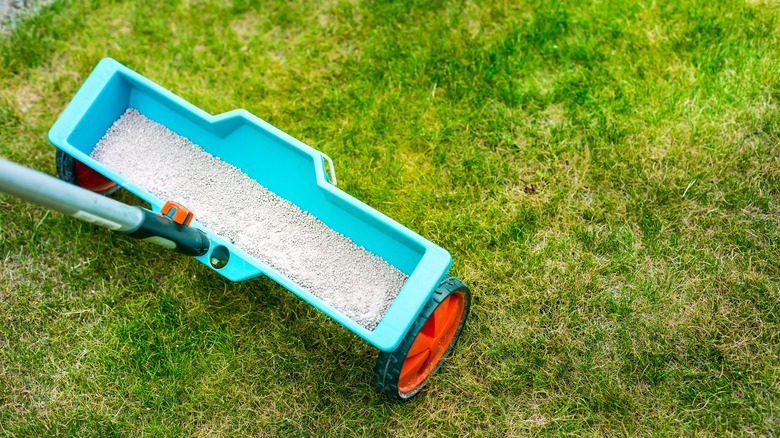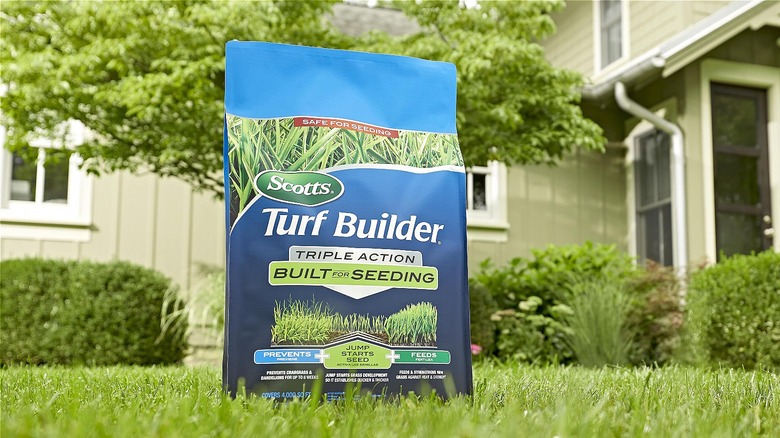Fertilizers are commonly used to keep lawns looking lush throughout the seasons. The wide variety of fertilizers on the market each serves a different purpose, so it can be difficult to determine which is most compatible with your lawn. This becomes even more complicated for those trying to figure out whether it’s appropriate to use the same type of fertilizer in the spring and fall. Timothy Hammond, owner of Big City Gardener, shared his expert insight on the perfect fertilizer to use on your lawn during either season in an exclusive interview with House Digest.
If you are wondering whether you can use the fertilizer you have on hand during both the spring and fall seasons, it turns out that this depends on the type of grass you have on your lawn. “I live in the southern United States, and we predominantly have St. Augustine grass, but depending on where you reside, you could have Zoysia, Bermuda, fescue, or other options,” Hammond shared.
He then explained why using the same fertilizer each season may not be the best move for your lawn. “For simplicity reasons, yes, you could technically use the same fertilizer year-round, but that won’t get you the best results,” the @bigcitygardener owner revealed. “All living things require different vitamins, nutrients, and other minerals to help achieve the perfect lawn.”
Lawns benefit from different macronutrients in the spring and fall

To find out whether a fertilizer is more appropriate for the spring or fall, you will have to take a look at its ingredients. “When lawns reawaken in springtime, they need a fertilizer high in nitrogen and potassium,” Timothy Hammond shared exclusively with House Digest. “In the fall and winter, lawns respond better to fertilizers with high phosphorus content.” If you want to follow in this expert’s footsteps, you might consider establishing a lawn care schedule to ensure your grass has what it needs to thrive all year round — even as the seasons change. This is the approach Hammond takes.
Hammond applies a fertilizer high in nitrogen with an NPK of 15-5-10 to his southern lawn from February to March, then a pre-emergent herbicide two weeks later. He revisits lawn care in early April by adding in granular trace minerals. In late April, he uses the same nitrogen-based fertilizer. Hammond gets ahead of the summertime temperature change by applying more slow-release fertilizer in June. Yellow patches might appear within the month of August, but he simply uses an iron supplement to turn the lawn back to a healthy dark green. From October to November, Hammond applies fungicide and switches to a fertilizer with more potassium than nitrogen.
How to identify a fertilizer’s macronutrients

At this point, you may be wondering how to determine what macronutrients make up your fertilizer’s formulation. With all of the different types and brands on store shelves, it can be difficult to identify which are richest in potassium, nitrogen, and so on. Luckily, Timothy Hammond shared a few tips that should make this process a lot easier. “When you walk into the aisle with fertilizers, you will see three numbers separated by hyphens on the bag,” the expert gardener said during his exclusive interview with House Digest. “These numbers represent the three primary macronutrients: nitrogen, phosphorus, and potassium.”
Hammond shared more about how to identify each of these macronutrients and their benefits. “Nitrogen is for green vegetative growth,” he continued. “Phosphorus, the second number, is responsible for fruiting, flowering, and strength of tissue wall. Potassium is the third and final number, and it is related to plant health, immunity, and root development.” He explained that these macronutrients are essential for a plant’s growth and development. Although they have different benefits, they are all equally important in maintaining your lawn’s health.




